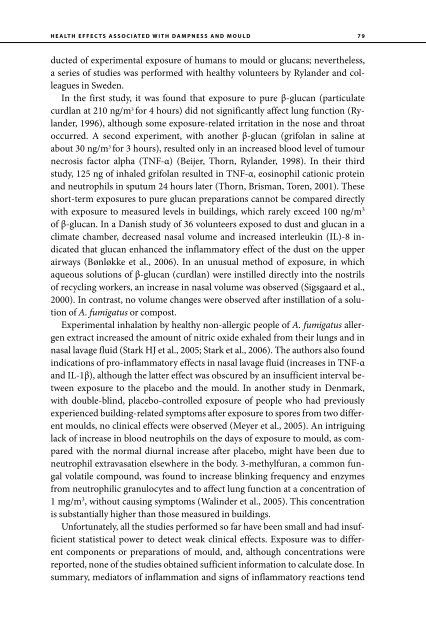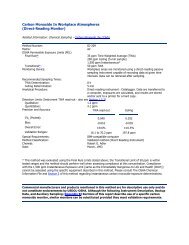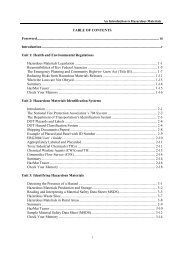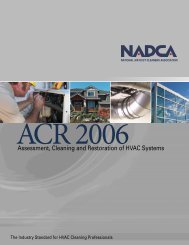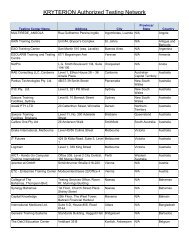Dampness and Mould - WHO guidelines for indoor air quality - PRWeb
Dampness and Mould - WHO guidelines for indoor air quality - PRWeb
Dampness and Mould - WHO guidelines for indoor air quality - PRWeb
You also want an ePaper? Increase the reach of your titles
YUMPU automatically turns print PDFs into web optimized ePapers that Google loves.
HEALTH EFFECTS ASSOCIATED WITH DAMPNESS AND MOULD<br />
79<br />
ducted of experimental exposure of humans to mould or glucans; nevertheless,<br />
a series of studies was per<strong>for</strong>med with healthy volunteers by Ryl<strong>and</strong>er <strong>and</strong> colleagues<br />
in Sweden.<br />
In the first study, it was found that exposure to pure β-glucan (particulate<br />
curdlan at 210 ng/m 3 <strong>for</strong> 4 hours) did not significantly affect lung function (Ryl<strong>and</strong>er,<br />
1996), although some exposure-related irritation in the nose <strong>and</strong> throat<br />
occurred. A second experiment, with another β-glucan (grifolan in saline at<br />
about 30 ng/m 3 <strong>for</strong> 3 hours), resulted only in an increased blood level of tumour<br />
necrosis factor alpha (TNF-α) (Beijer, Thorn, Ryl<strong>and</strong>er, 1998). In their third<br />
study, 125 ng of inhaled grifolan resulted in TNF-α, eosinophil cationic protein<br />
<strong>and</strong> neutrophils in sputum 24 hours later (Thorn, Brisman, Toren, 2001). These<br />
short-term exposures to pure glucan preparations cannot be compared directly<br />
with exposure to measured levels in buildings, which rarely exceed 100 ng/m 3<br />
of β-glucan. In a Danish study of 36 volunteers exposed to dust <strong>and</strong> glucan in a<br />
climate chamber, decreased nasal volume <strong>and</strong> increased interleukin (IL)-8 indicated<br />
that glucan enhanced the inflammatory effect of the dust on the upper<br />
<strong>air</strong>ways (Bønløkke et al., 2006). In an unusual method of exposure, in which<br />
aqueous solutions of β-glucan (curdlan) were instilled directly into the nostrils<br />
of recycling workers, an increase in nasal volume was observed (Sigsgaard et al.,<br />
2000). In contrast, no volume changes were observed after instillation of a solution<br />
of A. fumigatus or compost.<br />
Experimental inhalation by healthy non-allergic people of A. fumigatus allergen<br />
extract increased the amount of nitric oxide exhaled from their lungs <strong>and</strong> in<br />
nasal lavage fluid (Stark HJ et al., 2005; Stark et al., 2006). The authors also found<br />
indications of pro-inflammatory effects in nasal lavage fluid (increases in TNF-α<br />
<strong>and</strong> IL-1β), although the latter effect was obscured by an insufficient interval between<br />
exposure to the placebo <strong>and</strong> the mould. In another study in Denmark,<br />
with double-blind, placebo-controlled exposure of people who had previously<br />
experienced building-related symptoms after exposure to spores from two different<br />
moulds, no clinical effects were observed (Meyer et al., 2005). An intriguing<br />
lack of increase in blood neutrophils on the days of exposure to mould, as compared<br />
with the normal diurnal increase after placebo, might have been due to<br />
neutrophil extravasation elsewhere in the body. 3-methylfuran, a common fungal<br />
volatile compound, was found to increase blinking frequency <strong>and</strong> enzymes<br />
from neutrophilic granulocytes <strong>and</strong> to affect lung function at a concentration of<br />
1 mg/m 3 , without causing symptoms (Walinder et al., 2005). This concentration<br />
is substantially higher than those measured in buildings.<br />
Un<strong>for</strong>tunately, all the studies per<strong>for</strong>med so far have been small <strong>and</strong> had insufficient<br />
statistical power to detect weak clinical effects. Exposure was to different<br />
components or preparations of mould, <strong>and</strong>, although concentrations were<br />
reported, none of the studies obtained sufficient in<strong>for</strong>mation to calculate dose. In<br />
summary, mediators of inflammation <strong>and</strong> signs of inflammatory reactions tend


